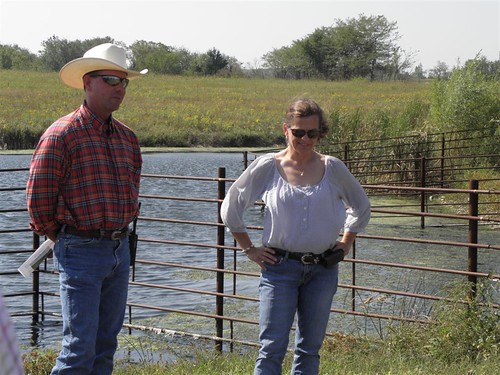
USDA’s Natural Resources Conservation Service is a federal agency that provides one-on-one conservation assistance to farmers, ranchers and other private landowners. We help landowners grow food and other crops in more efficient, environmentally friendly ways to protect the natural resources that we all depend upon—water, soil, air and wildlife. With 70 percent of land in the lower 48 states in private hands, the choices these landowners make truly determine the health of the environment.
But we’re not always good at telling the story of those landowners, their hard work and their committed stewardship to the rest of the public we serve. To hear their stories, and pass them along to you, I take every chance I get to visit them myself. So when Kansas U.S. Representative Jerry Moran recently invited me on his 10th “Partners in Conservation Tour” on September 20th I jumped at the chance.
The all-day tour included visits to several farms that participate in USDA conservation programs. Besides Rep. Moran and me, Congresswoman Lynn Jenkins and NRCS State Conservationist Eric Banks came, as well as representatives from partner groups such as the Kansas Farm Bureau, Kansas Livestock Association, Kansas Land Trust, Kansas State University, University of Kansas, The Nature Conservancy, Playa Lakes Joint Venture, Conservation Districts, Farm Service Agency, representatives from elected officials and numerous farmers and ranchers.
The focus of the tour was livestock production, and we traveled along I-70 from Lawrence to Manhattan, through an area called the Flint Hills. The Flint Hills are not only incredibly beautiful, but highly productive for grass-fed cattle.
If there was a theme among the farmers we visited on the conservation tour, it was “trying to do things right.” Each farmer repeated this message as he or she spoke about their commitment to conserving our natural resources.
South of Lawrence, John Bradley has worked to make his farm a model for conservation, installing several conservation practices, including a rock crossing for cattle to ford a creek on his property. The crossing reduces erosion on the creek’s banks and minimizes animal contact with water which leads to improved water quality. He also has developed a grazing system for his cows that is low stress for both him and his cows and extremely environmentally friendly. For John, conservation makes sense for the resource base, for his animals, and for him.
For the same reason, ranchers Barbara Downey and Joe Carpenter in Wabaunsee County fenced the cattle out of their pond, leaving access points where the cattle drink. They pride themselves in being good stewards of the land as well as producers who care for their animals.
Also in Wabaunsee County, Dan Imthurn is helping the environment through a new agricultural waste system that collects the waste from his feedlot where he holds it until he transfers it to his fields as fertilizer.
The Poland brothers and Rod Moyer, both in Geary County, separately chose to use the Grassland Land Reserve Program and the Farm and Ranch Lands Protection Program to preserve their native grass ranchlands. These ranchers want their lands to remain in agriculture, producing high quality cattle, grass and hay, while also protecting water quality and providing wildlife habitat.
You may realize that farms like these are incredibly important to our Nation’s economy and way of life, the health of our children and a sustainable future. But they’re also becoming increasingly instrumental in ensuring that the rest of the world has food to eat. The United Nations says world food output must grow by 70 percent over the next four decades to feed a projected extra 2.3 billion people by 2050. Much of that increased output will surely come from producers in the United States, including those along I-70 in Kansas.
Agricultural productivity and sustainability are not mutually exclusive concepts. For 75 years, NRCS has helped farmers pursue both goals. And over the next 75 years, we’ll continue to help people help the land, together with our partners—with an eye toward the world’s growing population.
This work doesn’t generate a lot of fanfare, but it is quietly revolutionary. And it’s happening on thousands of individual farms and ranches across the Nation. I wish all Americans had the chance to check out farms like the ones I saw in Kansas, to see how hard our producers work and how much they care for the environment.
In the meantime, I thank Rep. Moran for his long-time interest in conservation and for inviting me to participate in his tour. Oh, by the way, if you really like a great, home-cooked meal, be sure to stop by Deb’s Restaurant if you are ever in Alma, Kansas. It’s worth the trip.
Follow NRCS on Twitter.
Check out other conservation-related stories on the USDA blog.



